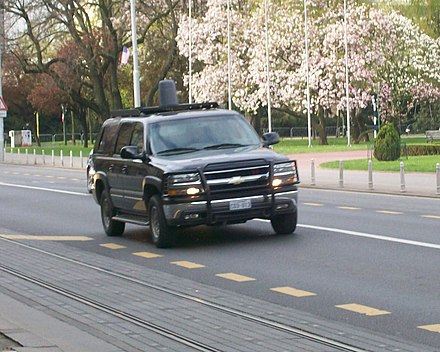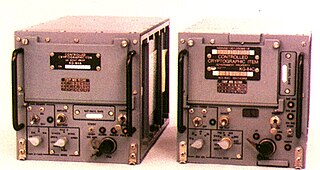
The White House Communications Agency Roadrunner Vehicle is an element of every American presidential motorcade. It is also known as the MC2V (Mobile command and Control Vehicle). The vehicle serves as the communications hub for the motorcade by encrypting duplex radio and streaming video which in turn is beamed up to a military satellite which in turn beams that data back down to a ground entry point and through to the WHCA switchboard.

The White House Communications Agency (WHCA), originally known as the White House Signal Corps (WHSC) and then the White House Signal Detachment (WHSD), was officially formed by the United States Department of War on 25 March 1942 under President Franklin D. Roosevelt. The organization was created to provide secure normal, secret, and emergency communications requirements in support of the President. The organization provided mobile radio, Teletype, telegraph, telephone and cryptographic aides in the White House and at "Shangri-La". The organizational mission was to provide a premier communication system that would enable the President to lead the nation effectively.

A motorcade, or autocade, is a procession of vehicles.
A duplex communication system is a point-to-point system composed of two or more connected parties or devices that can communicate with one another in both directions. Duplex systems are employed in many communications networks, either to allow for simultaneous communication in both directions between two connected parties or to provide a reverse path for the monitoring and remote adjustment of equipment in the field. There are two types of duplex communication systems: full-duplex (FDX) and half-duplex (HDX).
The vehicle is a heavily modified Chevrolet Suburban equipped with protective armor, runflat tires, vehicle transponder, and turbocharger. The most obvious feature is a configurable antennae platform mounted on the roof. This contains a large SATCOM dome containing a tracking dish that serves as the data uplink and downlink as the primary communications path for the motorcade. Also on the roof are smaller VHF antennas that serve as a repeater for the other motorcade elements as well as another communications path to local authorities and the onsite WHCA office. VHF antennae configuration changes according to the mission operational requirements. This also serves as the hub for the LCP or Limousine Control Package that allows C2 functions to be performed from USSS control cars, presidential parade limo or presidential suburban. 22 of these vehicles were built by Assurance Technology Corporation in Carlisle, MA and developed with NRL (Naval Research Laboratory).

The Chevrolet Suburban is a full-size SUV from Chevrolet. It is the longest continuous use automobile nameplate in production, starting in 1935 for the 1935 U.S. model year, and has traditionally been one of General Motors' most profitable vehicles. The 1935 first generation Carryall Suburban was one of the first production all-metal bodied station wagons.

In telecommunication, a transponder is a device that, upon receiving a signal, emits a different signal in response. The term is a portmanteau for transmitter-responder. It is variously abbreviated as XPDR, XPNDR, TPDR or TP.

A turbocharger, colloquially known as a turbo, is a turbine-driven forced induction device that increases an internal combustion engine's efficiency and power output by forcing extra compressed air into the combustion chamber. This improvement over a naturally aspirated engine's power output is due to the fact that the compressor can force more air—and proportionately more fuel—into the combustion chamber than atmospheric pressure alone.
The primary communications path was via the Defense Satellite Communications System (DSCS) III (U) satellite. There were nine of these satellites in orbit, each one providing six super high frequency encrypted data and voice channels and a single channel dedicated for Emergency Action Messages which would be used to direct a nuclear release from the motorcade.

The Defense Satellite Communications System (DSCS) provides the United States with military communications to support globally distributed military users. Beginning in 2007, DSCS is being replaced by the Wideband Global SATCOM system. A total of 14 DSCS-III satellites were launched between the early 1980s and 2003. Two satellites were launched aboard the Space Shuttle Atlantis in 1985 during the STS-51-J flight. As of 23 November 2015, seven DSCS-III satellites were still operational. DSCS operations are currently run by the 3d Space Operations Squadron out of Schriever Air Force Base.
Voice channels are all encrypted, most likely with FASCINATOR encryption. FASCINATOR is a digital voice encryption standard for the Federal Government. It is based on voice being digitized using 12 kbit/s Continuously Variable Slope Delta modulation (CVSD) and then encrypted using a National Security Agency (NSA) Commercial COMSEC Endorsement Program (CCEP) Type I encryption algorithm.
FASCINATOR is a series of Type 1 encryption modules designed in the late-1980s to be installed in Motorola digital-capable voice radios. These radios were originally built to accept a DES-based encryption module that was not approved by NSA for classified communications. The FASCINATOR modules replaced the DES units and can be used for classified conversations at all levels when used with appropriately classified keys. FASCINATOR operates at 12 kbit/s for encryption and decryption. It is not compatible with DES-based voice systems.











